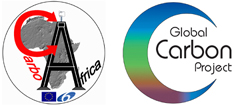the Creative Commons Attribution 3.0 License.
the Creative Commons Attribution 3.0 License.

Precipitation as driver of carbon fluxes in 11 African ecosystems
L. Merbold
J. Ardö
A. Arneth
R. J. Scholes
Y. Nouvellon
A. de Grandcourt
S. Archibald
J. M. Bonnefond
N. Boulain
N. Brueggemann
C. Bruemmer
B. Cappelaere
E. Ceschia
H. A. M. El-Khidir
B. A. El-Tahir
U. Falk
J. Lloyd
L. Kergoat
V. Le Dantec
E. Mougin
M. Muchinda
M. M. Mukelabai
D. Ramier
O. Roupsard
F. Timouk
E. M. Veenendaal
W. L. Kutsch
Abstract. This study reports carbon and water fluxes between the land surface and atmosphere in eleven different ecosystems types in Sub-Saharan Africa, as measured using eddy covariance (EC) technology in the first two years of the CarboAfrica network operation. The ecosystems for which data were available ranged in mean annual rainfall from 320 mm (Sudan) to 1150 mm (Republic of Congo) and include a spectrum of vegetation types (or land cover) (open savannas, woodlands, croplands and grasslands). Given the shortness of the record, the EC data were analysed across the network rather than longitudinally at sites, in order to understand the driving factors for ecosystem respiration and carbon assimilation, and to reveal the different water use strategies in these highly seasonal environments.
Values for maximum net carbon assimilation rates (photosynthesis) ranged from −12.5 μmol CO2 m−2 s−1 in a dry, open Millet cropland (C4-plants) up to −48 μmol CO2 m−2 s−1 for a tropical moist grassland. Maximum carbon assimilation rates were highly correlated with mean annual rainfall (r2=0.74). Maximum photosynthetic uptake rates (Fpmax) were positively related to satellite-derived fAPAR. Ecosystem respiration was dependent on temperature at all sites, and was additionally dependent on soil water content at sites receiving less than 1000 mm of rain per year. All included ecosystems dominated by C3-plants, showed a strong decrease in 30-min assimilation rates with increasing water vapour pressure deficit above 2.0 kPa.
- Article
(11872 KB) - Metadata XML
- BibTeX
- EndNote





